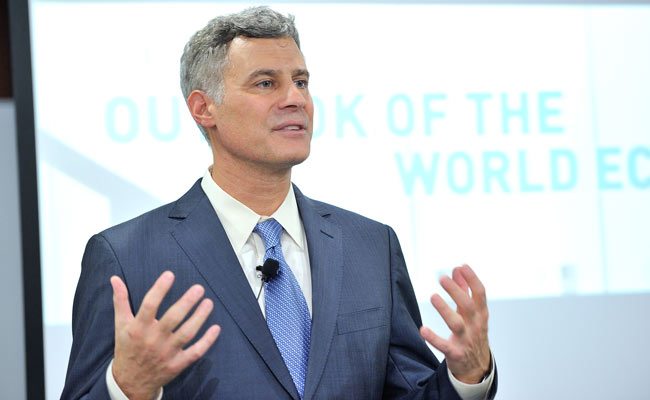Alan Krueger, former Chairman of the White House Council of Economic Advisors, shares his thoughts on the labor market, US economic recovery and the interplay with China.
As the US economy recovers from the recession, the labor market is steadily improving. The unemployment rate fell to 5.4% in April, the lowest level since May 2008, while the weekly initial claims of unemployment insurance are slowly going downwards as well. However, wage growth remained the missing piece in the otherwise rosy picture—hourly pay grew just 2.2% in April from a year earlier, barely above the inflation level.
While the income stagnation frustrates the American middle class, things are even worse for workers at the bottom who have to make a living on minimum wage (at the federal level the minimum wage is $7.25/hour). But any proposals today to raise the minimum wage rate can be controversial, as many claim that it’ll hurt the livelihood of small businesses and therefore, in turn, disserve the working poor.
Alan Krueger, Bendheim Professor of Economics and Public Affairs at Princeton University, doesn’t agree. “We have had minimum wage increases in the past, which have not had an adverse effect on employment,” the labor expert says. “We see many of the states step in the void [to raise the minimum rage]—I think that step would help lower-paid workers.”
In this interview, Krueger shares his analysis of the US economy and labor market; he also discusses how rising wages in China will impact the country’s growth and its economic relations with the US. Krueger served as the Chairman of the White House Council of Economic Advisors between November 2011 and August 2013; and between March 2009 and October 2010, he was the United States Assistant Secretary of the Treasury for Economic Policy.
Edited interview excerpts:
Q. Where’s the US economy today compared with where it was before the financial crisis in 2008?
A. I think the US economy is on stronger footing today than it was before the financial crisis. I think our financial sector is stronger and the reforms that were put in place, while not perfect, have made our financial system much less vulnerable today.
On the other hand we went through a very difficult time and I think that has repercussions. Investment slowed down and we’re not seeing the kind of productivity growth in our statistics that I would expect from the United States.
But if you look at our job growth today, it’s stronger than it was prior to the recession. Our unemployment rate is back down to about where it was prior to the recession and we are seeing signs of wage growth—real wages have started to grow again. GDP growth is not as strong as we would like, but it’s stronger than in most [countries] of the rest of the world.
So I think then economy in the US is continuing to recover and I expect over the next few years that recovery will continue.
Q. But one issue with the labor market is that most of the jobs added back to the economy are low-paid ones like workers in fast food chains. Will this trend continue?
A. I think we’ve had a trend for three decades where the job growth has been at the very bottom and at the very top and not enough in the middle. And I think we’re seeing a continuation of that trend. I don’t think we should expect it to turn around overnight, and I also don’t think that we’ve taken enough steps to address it.
The steps that are necessary to address this longer-term structural trend focus more on human capital, infrastructure investment, increasing demand for workers with moderate level of skills and raising the skills of the work force. We’ve made some progress in that area but not nearly enough.
Q. Technology advancement has eliminated many jobs. How can we help those workers who need new opportunities?
A. I think the history of the US has been that we’ve handled major transitions relatively well. We’ve gone from an agricultural economy to a more manufacturing economy, then to a service economy. And now we’re going to a post-service economy.
I suspect we’ll see the same kind of dynamic that we’ve seen in the past, which is existing workers who were displaced from sectors because of technological progress often do struggle and I think it’s incumbent on the rest of the country to try to help those individuals. It’s not their fault that they’ve been displaced—it has to do with forces beyond their means.
And I think it’s important that we have a strong social safety net, which helps them to support their families while they go through difficult adjustment times and that we also have a training system that enables them to make a transition to new industries.
But the fact has been that it is often very difficult for workers to make a transition, for example to move from manufacturing to healthcare. Healthcare is growing strongly in the US while manufacturing has contracted, not over the last few years, but over the last 25 years.
Also, I think it’s very important that we have the flexibility in our economy so that new sectors can open up and absorb the workers who are displaced from sectors that are experiencing very rapid productivity growth.
[Watch the video below]
Q. There’s also the wealth gap issue—incomes are stagnating for people at the bottom, but they are shooting up for those at the top. One way to address it from the government’s perspective is to raise the minimum wage, but it’s often controversial because some say that raising the minimum wage hurts the jobs market.
A. Part of the reason why we’ve seen wages decline for workers at the bottom is that we’ve had an erosion in the minimum wage. There has been a movement in many states to raise the minimum wage at the state-level, but not at the national level.
President Obama proposed raising the minimum wage up to $10 an hour a couple of years ago and Congress has not acted on that proposal. We see many of the states step in the void—I think that step would help lower-paid workers.
I don’t think it would put their jobs at risk—we’ve had minimum wage increases in the past, which have not had an adverse effect on employment, and I would expect that that type of a minimum wage level ($10/hour) would not have a noticeable effect on employment, but would raise wages considerably for lower-wage workers.
But there are other things that can be done as well. We can make sure that there’s a balance in terms of labor unions and management. The balance has tilted—it has become harder for labor unions to organize. There are steps that can be taken to try to expand collective action at work and I think we could do more to help workers who are freelancers.
That’s a growing sector, for example people who are driving for Uber, people who are working as independent contractors as photographers or as writers. There’s an organization, for example, called the Freelancers Union, which helps to support workers in those types of positions. The Affordable Care Act, the healthcare reform law passed under President Obama is a major step in that direction as well.
Q. Warren Buffett recently wrote an article in The Wall Street Journal arguing that expanding the Earned Income Tax Credit program is a better way to raise incomes for the working poor. What do you think of that?
A. I agree that raising minimum wage alone is not sufficient, but I think it is an important part of the solution and the minimum wage tends to work together with some of the tax and transfer programs that we have.
The economics of that, however, imply that companies can get away with paying even lower salaries because there’s a labor supply response to the Earned Income Tax Credit, and when the dust settles, the tax credit is partly offset because wages are lower than they otherwise would be. The minimum wage could help counteract that distortion, so I think they work in tandem.
Q. One new trend is that some manufacturing jobs are leaving China and returning to the US. Is that good for the US economy or is it simply a sign that wages are not growing much in the US?
A. I think it is a positive development. On the other hand, I think we also have to keep it in perspective.
What I think is happening fundamentally is that the world economy is equilibrating—wages have been growing very rapidly in China because China is getting pushed to its limits in terms of its existing infrastructure. The US, on the other hand, saw wages decline for manufacturing workers, so our unit labor cost became much more competitive with China and other countries. So as a result, manufacturing companies are in-shoring jobs—they’re moving jobs back to the US and I think that is beneficial.
The US lost almost seven million jobs in the manufacturing sector in the 2000s and we’ve added back a bit over a million since the recovery has started. We’re not making up the ground we lost but we’re moving in a better direction and it’s a lot easier to make a transition for workers if manufacturing is stable or adding some jobs as opposed to losing millions of jobs.
Q. How will rising wages affect the Chinese economy?
A. I think it’s healthy for China. I think one of the most important economic challenges China faces is to increase domestic consumption and I think it makes a lot of sense for a large share of that increase in domestic consumption to come from household consumption. And I think they particularly makes a lot of sense for that to occur as growth slows in China.
Q. In his book Unbalanced, the Codependence of America and China, Stephen Roach said that the two countries should rebalance their relations, which means that China should spend more and the US should save more and invest more. Do you think the transition will happen?
A. We’re seeing a little bit of decline in US consumption and in fact it’s a bit of a puzzle why households are not spending more money on consumption given that their incomes increased and given that energy prices have declined so much with the decline in the price of oil.
But I think that the most important rebalancing will take place in China because if you look at consumption relative to GDP, it is quite low in China compared to other countries with a similar level of economic development.
One change that I think would help to address that imbalance in China would be to reform the pension system to make pensions more secure. One of the reasons I think that Chinese households are saving so much is that they’re worried about their retirement years. A stronger pension system would enable people to spend more of their income today and raise the quality of life even if China does go through a period of lower growth.




















